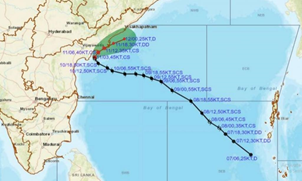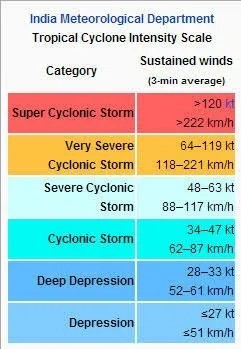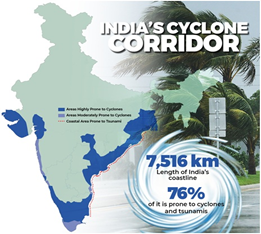

12th May 2022 (10 Topics)
Context
The cyclonic storm Asani weakened into a deep depression and crossed the Andhra Pradesh coast.
About
About Cyclone Asani:
- Cyclone Asani is brewing in the southern Andaman Sea.
- The name Cyclone Asani has been given by Sri Lanka. It means 'wrath' in Sinhalese.
- Cyclone Asani has weakened into a deep depression with a wind speed of 55-65 kmph gusting to 75 kmph.
- Gulab, Titli, Hudhud, Helen, and Lehar — these five cyclones have made landfall over Andhra Pradesh in the last 10 years.
- The cyclone that will form after Asani will be called Sitrang, a name given by Thailand.


What are Tropical Cyclones?
- Tropical cyclones, also known as typhoons or hurricanes, are among the most destructive weather phenomena.
- They are intense circular storms that originate over warm tropical oceans, and have maximum sustained wind speeds exceeding 119 kilometres per hour and heavy rains.
- However, the greatest damage to life and property is not from the wind, but from secondary events such as storm surges, flooding, landslides and tornadoes.
- Depending on its location and strength, a tropical cyclone is referred to by different names, including hurricane, typhoon, tropical storm, cyclonic storm, tropical depression, and simply cyclone.
- Hurricane: Atlantic Ocean
- Typhoon: North-western Pacific Ocean
- Tropical cyclones: South Pacific or the Indian Ocean


The new list:
- The list comprises names of 13 cyclones each for the 13 member countries, totaling to 169.
- The names for India include Gati, Tej, Murasu, Aag, Vyom, Jhar, Probaho, Neer, Prabhanjan, Ghurni, Ambud, Jaladhi and Vega.
- Some of the names for Bangladesh are Nisarga, Biparjoy, Arnab and Upakul.
- Tropical cyclones forming over different ocean basins are named by the concerned RSMCs & TCWCs.
- For north Indian Ocean, including Bay of Bengal and Arabian Sea, the RSMC, New Delhi, assigns the name to tropical cyclones following a standard procedure, an IMD release stated.
|
Indian Meteorological Department:
|


